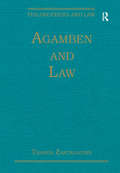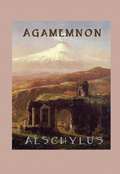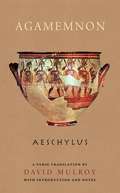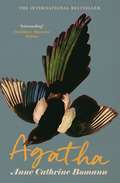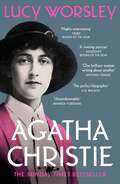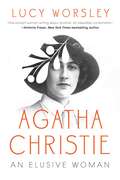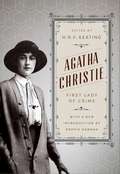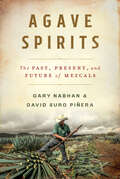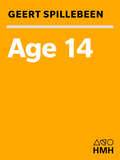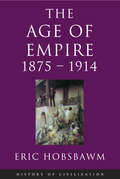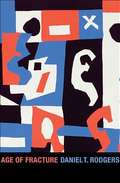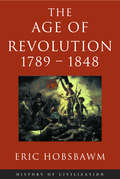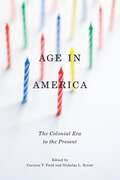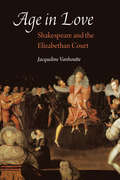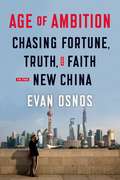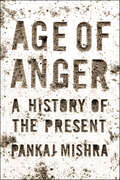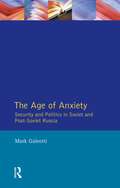- Table View
- List View
Agamben and Law: Power, Law And The Uses Of Criticism (Philosophers And Law Ser.)
by Thanos ZartaloudisThis collection of articles brings together a selection of previously published work on Agamben‘s thought in relation to law and gathered from within the legal field and theory in particular. The volume offers an exemplary range of varied readings, reflections and approaches which are of interest to readers, students and researchers of Agamben‘s law-related work.
Agamemnon
by AeschylusAeschylus' Agamemnon, first produced in 458 BC, is the opening play in his Oresteian trilogy. Agamemnon returns home after the Trojan Wars with his concubine Cassandra and is murdered by his wife Clytemnestra and her lover, Aegisthus. The ensuing blood feud continues until the third and final play, Eumenides, when peace is finally restored to the house of the Atreidae. It is a powerful and moving play which is difficult to interpret and which for a long time lacked an English edition.
Agamemnon
by Aeschylus David MulroyAgamemnon, King of Argos, returns to Greece a victor in the Trojan War. He has brought with him the seer Cassandra as his war-prize and concubine. Awaiting him is his vengeful wife Clytemnestra, who is angry at Agamemnon's sacrifice of their daughter Iphigeneia to the gods, jealous of Cassandra, and guilty of taking a lover herself. The events that unfold catch everyone in a bloody net, including their absent son Orestes. Aeschylus (525-456 BC) was the first of the three great tragic dramatists of ancient Greece, a forerunner of Sophocles and Euripides. His early tragedies were largely choral pageants with minimal plots. In Agamemnon, choral songs still predominate, but Aeschylus infuses them with such dramatic feeling that the spectator or reader is constantly spellbound. Translator David Mulroy brings this ancient tragedy to life for modern readers and audiences. Using end rhyme and strict metrics, he combines the buoyant lyricism of the Greek text with a faithful rendering of its meaning in lucid English.
Agatha
by Anne Cathrine BomannA psychiatrist is counting down towards his upcoming retirement. He lives alone in his childhood home and has neither friends nor family.Often, he resorts to drawing bird caricatures of his patients instead of taking notes. His social life consists of brief conversations with his meticulous secretary Madame Surrugue, who has reigned over the clinic for more than thirty years. The two of them have no relationship outside the office, where everything runs smoothly and uneventfully.Until one day, that is, when a young German woman called Agatha arrives and demands to see the doctor and he soon realizes that underneath her fragile exterior is a strong and fascinating woman. The doctor and Agatha embark upon a course of therapy together, a process that forces the doctor to confront his fear of true intimacy outside the clinic. But is it too late to reconsider your existence as a 71-year-old?
Agatha Christie: A Very Elusive Woman
by Lucy Worsley'One brilliant woman writing about another: an irresistible combination.' - Antonia Fraser'One of the most delightful biographies I have ever read.' - A.N. Wilson'Reading Worsley is as enjoyable as reading Christie herself.' - Ruth Scurr'Full of unique insight, eye opening detail, sharp analysis... Gripping.' - Kate Williams'Read it at one sitting. It's frothy and fast and properly, subtly, furious.' - Annie Gray'Nobody in the world was more inadequate to act the heroine than I was.'Why did Agatha Christie spend her career pretending that she was 'just' an ordinary housewife, when clearly she wasn't? As Lucy Worsley says, 'She was thrillingly, scintillatingly modern'. She went surfing in Hawaii, she loved fast cars, and she was intrigued by the new science of psychology, which helped her through devastating mental illness. So why - despite all the evidence to the contrary - did Agatha present herself as a retiring Edwardian lady of leisure? She was born in 1890 into a world which had its own rules about what women could and couldn't do. Lucy Worsley's biography is not just of an internationally renowned bestselling writer. It's also the story of a person who, despite the obstacles of class and gender, became an astonishingly successful working woman. With access to personal letters and papers that have rarely been seen, Lucy Worsley's biography is both authoritative and entertaining and makes us realise what an extraordinary pioneer Agatha Christie was - truly a woman who wrote the twentieth century.
Agatha Christie: A Very Elusive Woman
by Lucy Worsley'One brilliant woman writing about another: an irresistible combination.' - Antonia Fraser'One of the most delightful biographies I have ever read.' - A.N. Wilson'Reading Worsley is as enjoyable as reading Christie herself.' - Ruth Scurr'Full of unique insight, eye opening detail, sharp analysis... Gripping.' - Kate Williams'Read it at one sitting. It's frothy and fast and properly, subtly, furious.' - Annie Gray'Nobody in the world was more inadequate to act the heroine than I was.'Why did Agatha Christie spend her career pretending that she was 'just' an ordinary housewife, when clearly she wasn't? As Lucy Worsley says, 'She was thrillingly, scintillatingly modern'. She went surfing in Hawaii, she loved fast cars, and she was intrigued by the new science of psychology, which helped her through devastating mental illness. So why - despite all the evidence to the contrary - did Agatha present herself as a retiring Edwardian lady of leisure? She was born in 1890 into a world which had its own rules about what women could and couldn't do. Lucy Worsley's biography is not just of an internationally renowned bestselling writer. It's also the story of a person who, despite the obstacles of class and gender, became an astonishingly successful working woman. With access to personal letters and papers that have rarely been seen, Lucy Worsley's biography is both authoritative and entertaining and makes us realise what an extraordinary pioneer Agatha Christie was - truly a woman who wrote the twentieth century.
Agatha Christie: An Elusive Woman
by Lucy WorsleyA new, fascinating account of the life of Agatha Christie from celebrated literary and cultural historian Lucy Worsley."Nobody in the world was more inadequate to act the heroine than I was." Why did Agatha Christie spend her career pretending that she was &“just&” an ordinary housewife, when clearly she wasn&’t? Her life is fascinating for its mysteries and its passions and, as Lucy Worsley says, "She was thrillingly, scintillatingly modern." She went surfing in Hawaii, she loved fast cars, and she was intrigued by the new science of psychology, which helped her through devastating mental illness. So why—despite all the evidence to the contrary—did Agatha present herself as a retiring Edwardian lady of leisure? She was born in 1890 into a world that had its own rules about what women could and couldn&’t do. Lucy Worsley&’s biography is not just of a massively, internationally successful writer. It's also the story of a person who, despite the obstacles of class and gender, became an astonishingly successful working woman. With access to personal letters and papers that have rarely been seen, Lucy Worsley&’s biography is both authoritative and entertaining and makes us realize what an extraordinary pioneer Agatha Christie was—truly a woman who wrote the twentieth century.
Agatha Christie: First Lady of Crime
by Agatha ChristieFrom Poirot to Miss Marple, from The Mousetrap to Witness for the Prosecution, this a fascinating look at the life and work of Agatha Christie, the world's most successful and popular crime writer.Agatha Christie was not only the most successful author of detective stories the world has ever known, she was also a mystery in herself, giving only the rarest interviews—declining absolutely to become any sort of public figure—and a mystery, too, in the manner in which she achieved her astonishing success. Distinguished crime novelist (and acclaimed critic) H. R. F. Keating brings together a dozen noted writers from both sides of the Atlantic to throw light on the ever-intriguing Dame Agatha. Some essays analyze Christie&’s art itself; some explain the reasons for her success—not just the books, but also in film and theatre. The myriad of critical angles explored here are penetrating, affectionate, enthusiastic, analytical, and even funny. Together, they give an almost unique insight into the life and work of the First Lady of Crime. Includes essays by Sophie Hannah, H. R. F. Keating, Elizabeth Walter, Julian Symons, Edmund Crispin, Michael Gilbert, Emma Lathen, Colin Watson, Celia Fremlin, Dorothy B. Hughes, J. C. Trewin, Philip Jenkinson, William Weaver, and Christianna Brand.
Agatha Christie: The Sunday Times Bestseller
by Lucy Worsley'Paint(s) an intriguing picture of Christie.' - Guardian'Ms Worsley herself writes engagingly... She combines an almost militant support for her subject with a considered analysis of her books and plays.' - Economist'Admirably scrupulous' - New York Times'(An) authoritative and entertaining biography.' - Irish Independent'Written with... Lucy Worsley's trademark wit and wisdom, Agatha Christie emerges from the page as a thoroughly modern woman' - Red'Entertaining and authoritative, shining a light on just what an extraordinary pioneer Christie was.' - Belfast Telegraph'Nobody in the world was more inadequate to act the heroine than I was.'A new and fascinating account of the life of Agatha Christie from acclaimed historian Lucy Worsley.Why did Agatha Christie spend her career pretending that she was 'just' an ordinary housewife, when clearly she wasn't? As Lucy Worsley says, 'She was thrillingly, scintillatingly modern'. Her life was 'modern' too: she went surfing in Hawaii, she loved fast cars, and she was intrigued by the new science of psychology, which helped her through devastating mental illness.So why - despite all the evidence to the contrary - did Agatha present herself as a retiring Edwardian lady of leisure? She was born in 1890 into a world which had its own rules about what women could and couldn't do. Lucy Worsley's biography is not just of a massively, internationally successful writer. It's also the story of a person who, despite the obstacles of class and gender, became an astonishingly successful working woman.Agatha's life is fascinating for its mysteries and its passion.With access to personal letters and papers that have rarely been seen, Lucy Worsley's biography is both authoritative and entertaining and makes us realise what an extraordinary pioneer Agatha Christie was - truly a woman who wrote the twentieth century.(P)2022 Hodder & Stoughton Limited
Agatha: The International Bestseller
by Anne Cathrine BomannSet in 1940s Paris, this bittersweet international bestseller this is the perfect novel for fans of A Man Called Ove, My Name is Lucy Barton and The Guest CatA psychiatrist is counting down towards his upcoming retirement. He lives alone in his childhood home and has neither friends nor family.Often, he resorts to drawing bird caricatures of his patients instead of taking notes. His social life consists of brief conversations with his meticulous secretary Madame Surrugue, who has reigned over the clinic for more than thirty years. The two of them have no relationship outside the office, where everything runs smoothly and uneventfully.Until one day, that is, when a young German woman called Agatha arrives and demands to see the doctor and he soon realizes that underneath her fragile exterior is a strong and fascinating woman. The doctor and Agatha embark upon a course of therapy together, a process that forces the doctor to confront his fear of true intimacy outside the clinic. But is it too late to reconsider your existence as a 71-year-old?'A shrewd, skilful tale of loneliness, the search for meaning and a place in the world, and the problems of truly relating to another human being.' Independent
Agave Spirits: The Past, Present, And Future Of Mezcals
by Gary Paul Nabhan David Suro Piñera“A manifesto…[and] a positive spin on the future of mezcal.” —Florence Fabricant, New York Times The agave plant was never destined to become tasteless, cheap tequila. All tequilas are mezcals; all mezcals are made from agaves; and every bottle of mezcal is the remarkable result of collaborations among agave entrepreneurs, botanists, distillers, beverage distributors, bartenders, and more. How these groups come together in this “spirits world” is the subject of this fascinating new book by the acclaimed ethnobotanist Gary Paul Nabhan and the pioneering restauranteur David Suro Piñera. Join them as they delight in the diversity of the distillate agave spirits, as they endeavor to track down the more distant kin in the family of agaves, and as, along the way, they reveal the stunning innovations that have been transforming the industry around tequilas and mezcals in recent decades. The result of the authors’ fieldwork and on-the-ground interviews with mezcaleros in eight Mexican states, Agave Spirits shows how traditional methods of mezcal production are inspiring a new generation of individuals, including women, both in and beyond the industry. And as they reach back into a rich, centuries-long history, Nabhan and Suro Piñera make clear that understanding the story behind a bottle of mezcal, more than any other drink, will not only reveal what lies ahead for the tradition—including its ability to adapt in the face of the climate crisis—but will also enrich the drinking experience for readers. Essential reading for mezcal connoisseurs and amateurs interested in unlocking the past of a delightful distillate, Agave Spirits tells the tale of the most flavorful and memorable spirits humankind has ever sipped and savored. Featuring twelve illustrations by René Alejandro Hernández Tapia and indices that list common and scientific names for agave species, as well as the names of plants, animals, and domesticated agaves used in the production of distillates.
Age 14: Patrick Condon, Boy Soldier In Wwi
by Terese Edelstein Geert SpillebeenIt is 1913, and twelve-year-old Patrick Condon wants to escape his unexciting life in Ireland. So he hatches a plan. Not wanting to wait until he is old enough to join the army, Patrick lies and says he seventeen years old, and that his name is John Condon. Assuming the identity of his older brother, Patrick enlists. John fits in quickly, though it is obvious that John is not 17, or even 16. That doesn't matter. John is strong, fast, and a hard worker. He loves military life. This man's world is just what John wanted. But when WWI begins in 1914, John gets all he has been looking for, and more he does not expect, as he is just a boy...
Age Of Capital: 1848-1875
by Eric HobsbawmA magisterial account of the rise of capitalismEric Hobsbawm's magnificent treatment of the crucial years 1848-1875 is a penetrating analysis of the rise of capitalism and the consolidation of bourgeois culture. In the 1860s a new word entered the economic and political vocabulary of the world: 'capitalism'. The global triumph of capitalism is the major theme of history in the decades after 1848. The extension of capitalist economy to four corners of the globe, the mounting concentration of wealth, the migration of men, the domination of Europe and European culture made the third quarter of the nineteenth century a watershed. This is a history not only of Europe but of the world. Eric Hobsbawm's intention is not to summarise facts, but to draw facts together into a historical synthesis, to 'make sense of' the period, and to trace the roots of the present world back to it. He integrates economics with political and intellectual developments in this objective yet original account of revolution and the failure of revolution, of the cycles of boom and slump that characterise capitalist economies, of the victims and victors of the bourgeois ethos.
Age Of Capital: 1848-1875
by Prof Eric HobsbawmA magisterial account of the rise of capitalismEric Hobsbawm's magnificent treatment of the crucial years 1848-1875 is a penetrating analysis of the rise of capitalism and the consolidation of bourgeois culture. In the 1860s a new word entered the economic and political vocabulary of the world: 'capitalism'. The global triumph of capitalism is the major theme of history in the decades after 1848. The extension of capitalist economy to four corners of the globe, the mounting concentration of wealth, the migration of men, the domination of Europe and European culture made the third quarter of the nineteenth century a watershed. This is a history not only of Europe but of the world. Eric Hobsbawm's intention is not to summarise facts, but to draw facts together into a historical synthesis, to 'make sense of' the period, and to trace the roots of the present world back to it. He integrates economics with political and intellectual developments in this objective yet original account of revolution and the failure of revolution, of the cycles of boom and slump that characterise capitalist economies, of the victims and victors of the bourgeois ethos.
Age Of Empire: 1875-1914
by Eric HobsbawmTHE AGE OF EMPIRE is a book about the strange death of the nineteenth century, the world made by and for liberal middle classes in the name of universal progress and civilisation. It is about hopes realised which turned into fears: an era of unparalleled peace engendering an era of unparalleled war; revolt and revolution emerging on the outskirts of society; a time of profound identity crisis for bourgeois classes, among new and sudden mass labour movements which rejected capitalism and new middle classes which rejected liberalism. It is about world empires built and held with almost contemptuous ease by small bodies of Europeans which were to last barely a human lifetime, and a European domination of world history, which was never more confident than at the moment it was about to disappear for ever. It is about Queen Victoria, Madame Curie and the Kodak Girl, and the novel social world of cloth caps, golf clubs and brassieres, about Nietzsche, Carnegie, William Morris and Dreyfus, about politically ineffective terrorists, one of whom, to his and everyone's surprise, started a world war.With the AGE OF EMPIRE, Eric Hobsbawm, Britain's leading historian of the left, brings to a dazzling climax his brilliant interpretative history of 'the long nineteenth century'.
Age Of Empire: 1875-1914
by Prof Eric HobsbawmTHE AGE OF EMPIRE is a book about the strange death of the nineteenth century, the world made by and for liberal middle classes in the name of universal progress and civilisation. It is about hopes realised which turned into fears: an era of unparalleled peace engendering an era of unparalleled war; revolt and revolution emerging on the outskirts of society; a time of profound identity crisis for bourgeois classes, among new and sudden mass labour movements which rejected capitalism and new middle classes which rejected liberalism. It is about world empires built and held with almost contemptuous ease by small bodies of Europeans which were to last barely a human lifetime, and a European domination of world history, which was never more confident than at the moment it was about to disappear for ever. It is about Queen Victoria, Madame Curie and the Kodak Girl, and the novel social world of cloth caps, golf clubs and brassieres, about Nietzsche, Carnegie, William Morris and Dreyfus, about politically ineffective terrorists, one of whom, to his and everyone's surprise, started a world war.With the AGE OF EMPIRE, Eric Hobsbawm, Britain's leading historian of the left, brings to a dazzling climax his brilliant interpretative history of 'the long nineteenth century'.
Age Of Fracture
by Daniel T. RodgersIn the last quarter of the twentieth century, the ideas that most Americans lived by started to fragment. Mid-century concepts of national consensus, managed markets, gender and racial identities, citizen obligation, and historical memory became more fluid. Flexible markets pushed aside Keynesian macroeconomic structures. Racial and gender solidarity divided into multiple identities; community responsibility shrank to smaller circles. In this wide-ranging narrative, Daniel Rodgers shows how the collective purposes and meanings that had framed social debate became unhinged and uncertain. Age of Fracture offers a powerful reinterpretation of the ways in which the decades surrounding the 1980s changed America. Through a contagion of visions and metaphors, on both the intellectual right and the intellectual left, earlier notions of history and society that stressed solidity, collective institutions, and social circumstances gave way to a more individualized human nature that emphasized choice, agency, performance, and desire. On a broad canvas that includes Michel Foucault, Ronald Reagan, Judith Butler, Charles Murray, Jeffrey Sachs, and many more, Rodgers explains how structures of power came to seem less important than market choice and fluid selves. Cutting across the social and political arenas of late-twentieth-century life and thought, from economic theory and the culture wars to disputes over poverty, color-blindness, and sisterhood, Rodgers reveals how our categories of social reality have been fractured and destabilized. As we survey the intellectual wreckage of this war of ideas, we better understand the emergence of our present age of uncertainty.
Age Of Revolution: 1789-1848
by Eric HobsbawmThe first in Eric Hobsbawm's dazzling trilogy on the history of the nineteenth century.Between 1789 and 1848 the world was transformed both by the French Revolution and also by the Industrial Revolution that originated in Britain. This 'Dual Revolution' created the modern world as we know it.Eric Hobsbawm traces with brilliant analytical clarity the transformation brought about in every sphere of European life by the Dual Revolution - in the conduct of war and diplomacy; in new industrial areas and on the land; among peasantry, bourgeoisie and aristocracy; in methods of government and of revolution; in science, philosophy and religion; in literature and the arts. But above all he sees this as the period when industrial capitalism established the domination over the rest of the world it was to hold for a century.Eric Hobsbawm's enthralling and original account is an impassioned but objective history of the most significant sixty years in the history of Europe.
Age Of Revolution: 1789-1848
by Prof Eric HobsbawmThe first in Eric Hobsbawm's dazzling trilogy on the history of the nineteenth century.Between 1789 and 1848 the world was transformed both by the French Revolution and also by the Industrial Revolution that originated in Britain. This 'Dual Revolution' created the modern world as we know it.Eric Hobsbawm traces with brilliant analytical clarity the transformation brought about in every sphere of European life by the Dual Revolution - in the conduct of war and diplomacy; in new industrial areas and on the land; among peasantry, bourgeoisie and aristocracy; in methods of government and of revolution; in science, philosophy and religion; in literature and the arts. But above all he sees this as the period when industrial capitalism established the domination over the rest of the world it was to hold for a century.Eric Hobsbawm's enthralling and original account is an impassioned but objective history of the most significant sixty years in the history of Europe.
Age and Identity in Eighteenth-Century England ("The Body, Gender and Culture" #11)
by Helen YallopYallop looks at how people in eighteenth-century England understood and dealt with growing older. Though no word for ‘aging’ existed at this time, a person’s age was a significant aspect of their identity.
Age in America: The Colonial Era to the Present (Gender And American Culture Ser.)
by Nicholas L. Syrett Corinne T. FieldEighteen. Twenty-one. Sixty-five. In America today, we recognize these numbers as key transitions in our lives—precise moments when our rights and opportunities change—when we become eligible to cast a vote, buy a drink, or enroll in Medicare. This volume brings together scholars of childhood, adulthood, and old age to explore how and why particular ages have come to define the rights and obligations of American citizens. Since the founding of the nation, Americans have relied on chronological age to determine matters as diverse as who can marry, work, be enslaved, drive a car, or qualify for a pension. Contributors to this volume explore what meanings people in the past ascribed to specific ages and whether or not earlier Americans believed the same things about particular ages as we do. The means by which Americans imposed chronological boundaries upon the variable process of growing up and growing old offers a paradigmatic example of how people construct cultural meaning and social hierarchy from embodied experience. Further, chronological age always intersects with other socially constructed categories such as gender, race, and sexuality. Ranging from the seventeenth century to the present, taking up a variety of distinct subcultures—from frontier children and antebellum slaves to twentieth-century Latinas—Age in America makes a powerful case that age has always been a key index of citizenship.
Age in Love: Shakespeare and the Elizabethan Court (Early Modern Cultural Studies)
by Jacqueline VanhoutteThe title Age in Love is taken from Shakespeare’s sonnet 138, a poem about an aging male speaker who, by virtue of his entanglement with the dark lady, “vainly” performs the role of “some untutor’d youth.” Jacqueline Vanhoutte argues that this pattern of “age in love” pervades Shakespeare’s mature works, informing his experiments in all the dramatic genres. Bottom, Malvolio, Claudius, Falstaff, and Antony all share with the sonnet speaker a tendency to flout generational decorum by assuming the role of the lover, normally reserved in Renaissance culture for young men. Hybrids and upstarts, cross-dressers and shape-shifters, comic butts and tragic heroes—Shakespeare’s old-men-in-love turn in boundary-blurring performances that probe the gendered and generational categories by which early modern subjects conceived of identity. In Age in Love Vanhoutte shows that questions we have come to regard as quintessentially Shakespearean—about the limits of social mobility, the nature of political authority, the transformative powers of the theater, the vagaries of human memory, or the possibility of secular immortality—come to indelible expression through Shakespeare’s artful deployment of the “age in love” trope. Age in Love contributes to the ongoing debate about the emergence of a Tudor public sphere, building on the current interest in premodern constructions of aging and ultimately demonstrating that the Elizabethan court shaped Shakespeare’s plays in unexpected and previously undocumented ways.
Age of Ambition: Chasing Fortune, Truth, and Faith in the New China
by Evan OsnosWinner of the 2014 National Book Award in nonfiction. An Economist Best Book of 2014. A vibrant, colorful, and revelatory inner history of China during a moment of profound transformation From abroad, we often see China as a caricature: a nation of pragmatic plutocrats and ruthlessly dedicated students destined to rule the global economy-or an addled Goliath, riddled with corruption and on the edge of stagnation. What we don't see is how both powerful and ordinary people are remaking their lives as their country dramatically changes  As the Beijing correspondent for The New Yorker, Evan Osnos was on the ground in China for years, witness to profound political, economic, and cultural upheaval. In Age of Ambition, he describes the greatest collision taking place in that country: the clash between the rise of the individual and the Communist Party's struggle to retain control. He asks probing questions: Why does a government with more success lifting people from poverty than any civilization in history choose to put strict restraints on freedom of expression? Why do millions of young Chinese professionals-fluent in English and devoted to Western pop culture-consider themselves "angry youth," dedicated to resisting the West's influence? How are Chinese from all strata finding meaning after two decades of the relentless pursuit of wealth? Writing with great narrative verve and a keen sense of irony, Osnos follows the moving stories of everyday people and reveals life in the new China to be a battleground between aspiration and authoritarianism, in which only one can prevail.
Age of Anger: A History of the Present
by Pankaj MishraA New York Times Notable Book of 2017 • Named a Best Book of the Year by Slate and NPR • Longlisted for the Orwell PrizeOne of our most important public intellectuals reveals the hidden history of our current global crisisHow can we explain the origins of the great wave of paranoid hatreds that seem inescapable in our close-knit world—from American shooters and ISIS to Donald Trump, from a rise in vengeful nationalism across the world to racism and misogyny on social media? In Age of Anger, Pankaj Mishra answers our bewilderment by casting his gaze back to the eighteenth century before leading us to the present.He shows that as the world became modern, those who were unable to enjoy its promises—of freedom, stability, and prosperity—were increasingly susceptible to demagogues. The many who came late to this new world—or were left, or pushed, behind—reacted in horrifyingly similar ways: with intense hatred of invented enemies, attempts to re-create an imaginary golden age, and self-empowerment through spectacular violence. It was from among the ranks of the disaffected that the militants of the nineteenth century arose—angry young men who became cultural nationalists in Germany, messianic revolutionaries in Russia, bellicose chauvinists in Italy, and anarchist terrorists internationally.Today, just as then, the wide embrace of mass politics and technology and the pursuit of wealth and individualism have cast many more billions adrift in a demoralized world, uprooted from tradition but still far from modernity—with the same terrible results.Making startling connections and comparisons, Age of Anger is a book of immense urgency and profound argument. It is a history of our present predicament unlike any other.
Age of Anxiety, The: Security and Politics in Soviet and Post-Soviet Russia
by Mark GaleottiThe geography of Russia -- vast, unwieldy, exposed -- and her tragic history of foreign invasion have created an overriding sense of military vulnerability amongst her leaders that, after the horrors of the Second World War, amounted almost to paranoia. This important study of the years since Brezhnev shows how this obsession with national security have been at the core of Russian thinking right through the reforms of the Gorbachev era and the eventual collapse of the USSR, and continues to dominate the turbulent politics of post-Soviet Russia today.
